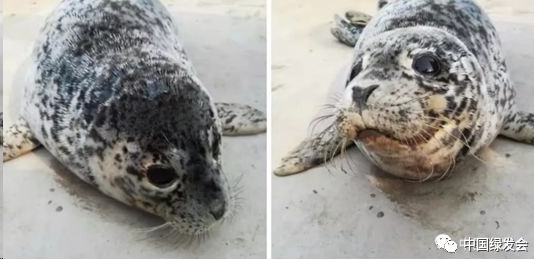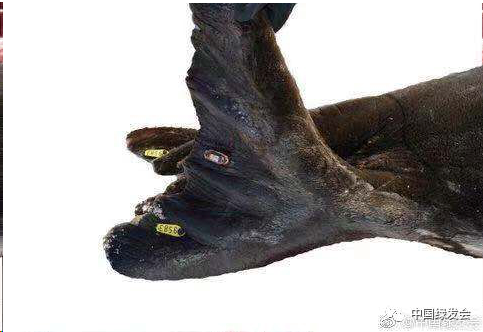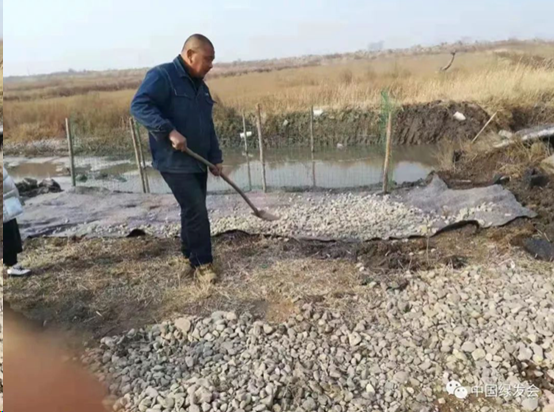On March 24, Gousheng, the first spotted seal pup rescued by fishermen and volunteers from China Biodiversity Conservation and Green Development Foundation (CBCGDF), will have the bliss of returning to its nature “home”. By then, CBCGDF’s “Spotted Seal Girl”, together with staffs from China Spotted Seal Conservation Area in Panjin and three other conservation areas, will supervise the whole release process. "We have been ramping up our pace at the final preparatory stage, and all signs have been promising. Yet we have been increasingly concerned with how to better track ‘Dog Left' after this release", said, "Spotted Seal Girl" a few days ago when asked about Gousheng’s returning home.
It was on the afternoon of February 21 that Gousheng was found and saved by the Director Tian Zhiwei from CBCGDF’s China Waterfowl Conservation Area in Tangshan. At that time, Gousheng had not had all its lanugo replaced, which meant that professional rescuing procedures were essential for its survival. As was duly followed by Director Tian Zhiwei and other rescuing workers in Tangshan.
In fact, the release decision was not easily taken. Dr. Sara Platto, CBCGDF’s invited councilor for endangered animals, once noted: “Release should not be allowed until after the weaning period and the seal pups are able to free feed, while free-feeding means, when in the pool, seal pups can catch and eat fish themselves. This is to ensure that seal pups will not be exposed to survival risks after release”.
Dr. Zhou Jinfeng, CBCGDF’s Secretary-General, likewise reminded: “Seal pups would not be prepared enough for a natural release if they have not developed abilities to free feed. Typically, seal pups will go through four stages of feeding, i.e. from use of syringes, hand-feeding, free-feeding during hand-feeding, to independent free-feeding”.
The overarching principle that has guided CBCGDF’s rescuing work of spotted seals is to do (only) what is really needed for the seals’ rehabilitation, health and safety. Therefore, it was not easy to arrive at the eventual release decision.
Close observations and notes of Gousheng’s health conditions are part of the daily routines that have been strictly followed by staffs at the rescuing spots, in order to determine whether Gousheng may be ready for a natural release.
“Gousheng is able to catch fishes by itself now”, said Director Tian Zhiwei, “And its weight has correspondingly increased to 28 kg. We are now building a pool for Gousheng so as to more positively train it to free feed in a simulated sea environment. Seawater has been channeled into the pool whose bottom is covered with pebbles of various sizes, depending on the depth”. Director Tian Zhiwei also noted that rescuing protection may, in fact, be harmful to seal pups if they become too reliant on human care.
The releasing spot will be in Panjin, according to Director Tian Jiguang from China Spotted Seal Conservation Area in Panjin. This is because Panjin in the coming months will be where a considerable number of spotted seals is expected to be on shore. Director Tian Zhiwei welcomed this idea. He said that the Panjin’s proximity to the rescuing spot could prevent Gousheng from being harmed by a long journey.
Despite this, “Spotted Seal Girl” has remained cautious on Gousheng’s returning home. One reason is that, as Dr. Sara Platto has suggested, scientific and accurate tracking of the released pups are important after releasing. It is because trackers will not only record the precise traveling route and details of the released pups, they will also help draw a clearer picture of how the pups will adapt to the natural sea environment and survive there, and how they will develop their lifestyles and carry out reproductive activities. They will all contribute a more scientific analysis of spotted seals, and more efficient rescuing efforts surrounding spotted seals.
Since last week, CBCGDF has been actively seeking help from Liaoning Ocean and Fisheries Science Research Institute, Max Planck Institute, Bernie Mc Connell, and California Marine Mammal Center for support on scientific tracking. We remain working hard on this, with fingers crossed.



(Photo credit: CBCGDF volunteers)
By / Lu Lei
